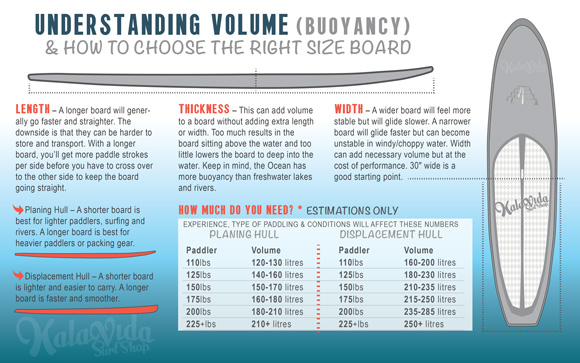Stand Up Paddle-Boarding is a fun and exciting low impact method to explore your local waterways. Lets talk about some of the basics you will need to know before "diving in"
Basic Equipment:
Stand Up Paddle-Board- Starting out you will want to get a SUP that is stable and user friendly. Think about what it is going to take to get yourself and your board to the water and consider purchasing something that will make life easy for you. Inflatables are a great first board option since they are easy to store and get to and from the water. Hard Boards will perform better. If you go with a hard board make sure there is enough volume in the board to match your stature.
Learn more about Choosing a Stand Up Paddle-Board

Image: KalavidaSurfShop.com
Stand Up Paddle- The paddle serves as your motor while out on the water and is the one piece of gear to be optimized. Go with the lightest paddle that you are comforatable purchasing. These lightweight paddles are built with composite materials such as fiberglass or carbon fiber from companies like Werner or Kialoa. The proper paddle can really make or break your day on the water.
Sizing your SUP Paddle. As a general rule of the, take your height in inches and add 10.
Learn more about Choosing a Stand Up Paddle
Leash- Connects you to your board. A prperly worn leash acts as your most important piece of safety equipment. The leash is used to keep you and your board connected. So if you end up "in the drink" your board is always close at hand.
Life Jacket- There two paths to go here. The first is a life jacket cut specfically for enhanced range of motion. The second option, for strong swimmers, is an inflatable belt pack. These are much less bulky of course and should used by paddlers who a bit more on / in water experience.
Proper Clothing- What you wear needs to match the risk for your paddle. Cold Air and Cold Water require more insulati0on. Warm air and Warm Water require less. Some other things to consider when chossing your clothing are:
- Your Experience Level
- Are you Paddling Alone?
- Are you staying close to Shore?
At the very least it is a good idea to have some sunglasses, a hat and of course the appropriate clothing for the day.
Learn more about Dressing for Paddle Sports
Basic Stand Up Paddle-Boarding Techniques:
After some basic instruction most paddlers are able to stand up their first time out on a SUP. Here are some basic tips to help get you started.
Standing Up: Start of on your knees or rear end to get the feel for the board and the paddle. Use this time to find the center of the board. Most SUP's have a carry handle, use the handle to reference the center of the board. When it comes to stand up you are going to get on your hands and knees, placing the paddle perpendicular from the board. Make sure that while you are in this position your feet are near the center of the board. From your hands and knees step one foot forward so have one foot on the board and one knee. Step your second foot forward and stand up!
Keeping your Balance: Once standing make sure your feet are about shoulder width apart and your toes are pointing toward the nose of your board. Your knees should be bent and your back straight. Let your knees and lower legs move freely with the board. They will act a bit like shocks on your vehicle. Once you are in a good position take a stroke. Like a bicycle a SUP is more stable while moving. Keep your head up and your eyes looking toward the horizon. Pro Tip: RELAX! you are having fun.
Holding your Paddle: When starting out is is super common to hold the paddle incorrectly. Keep the following in mind. Make sure the tear-drop-shaped blade of the paddle angles away from you and toward the nose of the board. When you’re paddling on the right side of your board, your left hand will be on the T-grip and your right hand a few feet down on the shaft. When you switch sides, reverse your hand positions.
Basic Stand Up Paddle Strokes
Forward Stroke: Reach your paddle blade forward towards the nose of the board by extending your bottom arm and twisting your hips. Insert the blade completely into the water by pushing down with your top hand on the T-Grip. Pull the blade through the water by untwisting. Stop the stroke at your heel.
Try and think of the stroke like this. Imagine you are planting the paddle in the mud and pulling yourself past the paddle with evey stroke.
Think about engaging you larger more powerful muscle groups like your abdominals and back to do the work, instead of the smaller muscles in your arms. This will allow you to stay out on the water longer with less fatigue.
The closer you can keep the paddle to the side of the board and the more vertical your blade is the straighter you will paddle.
Pro Tip: Stack your hands. One hand should be directly above the other.
Reverse Stroke:The reverse is basically the opposite of the forward stroke and is used to stop and turn. Like with the forward stroke, keep your arms straight and twist from your torso rather than pulling the blade forward with your arms.
Sweep Stroke: The sweep stroke is useful for turning your board while standing still or moving.If you’re paddling on the right, rotate your shoulders so that your right shoulder comes forward. Reach forward and plant your paddle in the water, submerging the entire blade.Sweep the paddle away from the board in a big arcing motion from the nose of the board to the tail by rotating your torso and using the leverage of your legs and hips. Doing the sweep stroke on the right side of your board will turn the board to the left and vice versa.
Pro Tip: Bend your knees and get low like a ninja. The more you bend those knees the further the blade will extend from the side of the board. Your hands should be parallel.
Choosing a Location to Paddle:
When you are first starting out stick to protected waterways and stay close to shore. Always check the forecast to ensure there is little to no wind as well. If there is wind at your location it is best to paddle into the wind first and use it to get you back to your starting point.
Nice sandy beaches also are best. These spots are easier on both your board and your body.
Pro Tip: Always paddle with a buddy!
Learn more about On Water Safety
